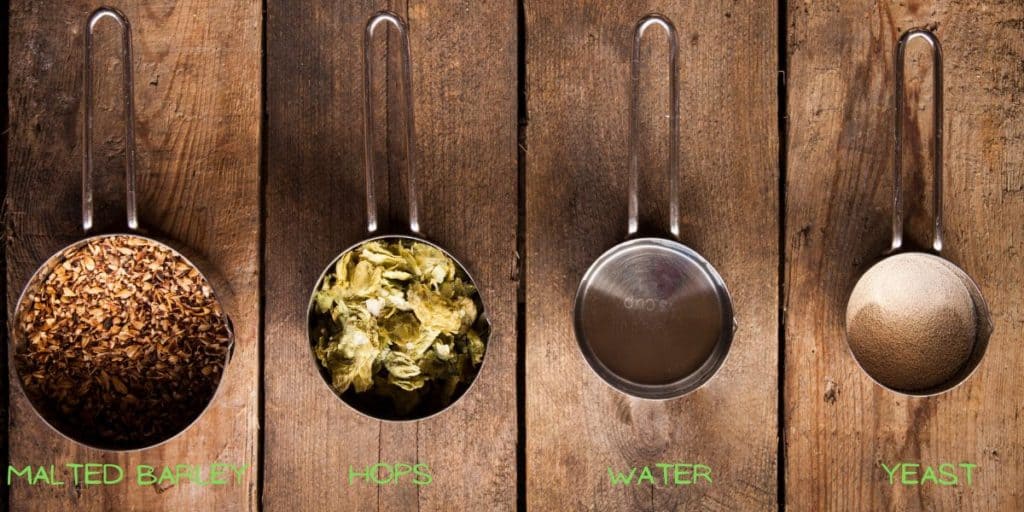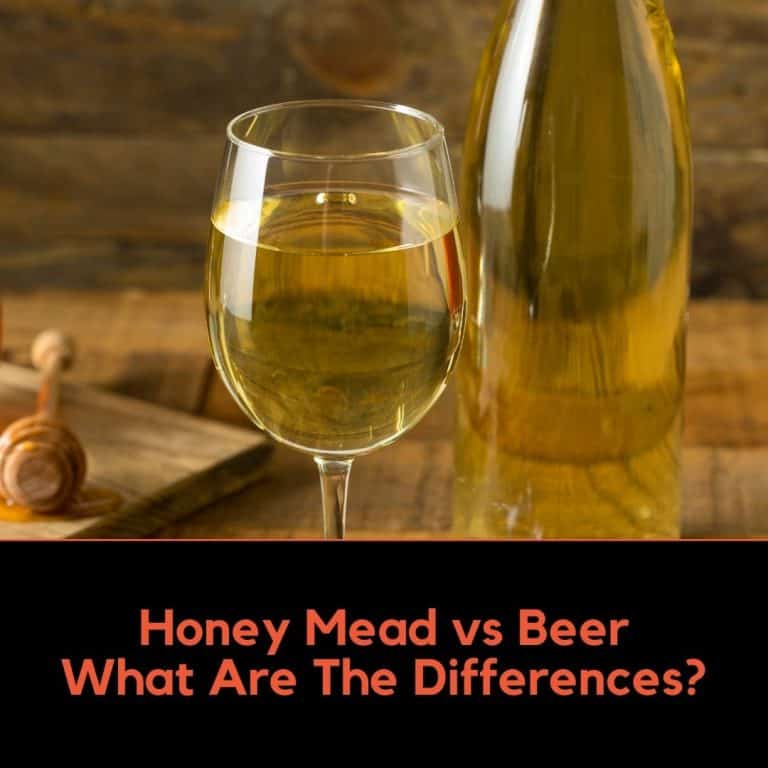Mead is known as one of the oldest alcoholic beverages in the history of fermentation. The popular drink among ancient greeks was called “nectar of the gods”. Traditional mead is not much different today as it was in the middle ages. It is a simple fermentation process involving, at its most basic of levels, honey, water, and yeast. So mead vs. beer, what is the difference and why is its own category?
What is Mead
Mead is a fermented alcoholic drink made from honey. This is where it gets its nickname Honey wine. It is straightforward and not nearly as complex as the juggling act that brewing craft beer is. Brewing an ale is a complex relationship between the types of grains used, how well you can extract the fermentable sugars from the crushed grains, and how you then balance the sweetness with bittering agents like hops.
Due to its simplistic fermentation process vs an ale, it is sometimes called honey wine. Do not be tricked though as mead is not wine either. The big difference is that wine is produced from the fermentation of the fruit juices of grapes, while mead is made with fermented honey. It is not uncommon though to have a mead that is fermented using a wine yeast, or champagne yeast for dry sparkling meads.
The champagne yeast results in a dry mead and bottle conditions well. As for sweet vs dry meads, not all meads are going to fall into the sweet mead category either. They will always have a bit of sweetness undertones from the flavor of the honey but they are not incredibly sweet by any means. Just like beer and wine, mead is its own style and category of alcoholic beverage.
What is Beer
Beer is one of two things. An ale or a lager. Regardless of the beer styles, they are all comprised of malted and toasted cereal grains such as barley and hops. Brewing involves first using hot water to steep the cracked grains to extract the sugars. This sweet cereal water is then boiled again to remove proteins. During this final boil, hops are introduced.
Hops are what are called the bittering agents. The early the hops are added the more bitter the result as their aroma oils are boiled off. This bittering is what balances the sweetness of the malt water. The more hops that are added the more the distinctive bitter taste the beer will have. And depending on when the hops are added, the ale can become more arromatic and floral.
New England and Smash pale ales are great examples of indian pale ales that have nearly all the hops added at the very end of the boil. This results in an intensely floral IPA without the bitterness.
After bittering, the beer is then chilled and yeast is added to begin a 2 to 4-week fermentation cycle. Depending on the temperature of the fermentation and the yeast used you will end up with either a lager or an ale. The ABV(alcohol by volume) of lagers and ales ranges from 3% to 7% with a handful of styles that go above that range. These are usually labeled imperials, doubles, or strong ales.
Because of the potential variables in grains, fermentable sugar additions like maple syrup, hops, and spices, craft beer has a hugely wide range of flavors and styles compared to meads. There are a lot of beer yeasts that are used, both for lagers and ales that produce a wide range of beer styles.
Even the different types of ale yeast produce different characteristics depending on the temperature of fermentation. Belgian yeasts for example can give you either a bubble gum flavor or banana and clove.

Types of Meads
Mead on the other hand does not always follow the complexities of brewing beer. It is its category and should not be lumped in with beer and wine, or cider. It is fermented honey using basic ingredients. Mead vs beer is farther off than comparing mead vs wine.
You will find a few styles of honey wines (mead) described below with an ABV ranging from 6 to 20 percent. If you are having trouble figuring out what a great mead is, here is a link to Drizly. Sort it to your location and it will give you options and reviews for meads available near you. Then start drinking mead to find your favorite style.
Session meads
Are like the ones I mentioned earlier. 2 main ingredients plus a basic yeast. The brewing process is similar in the fact that you are using fermentable sugars to produce an alcoholic beverage. Today you will find the drink of the gods in a few forms and a mead taste to fit everyone.
Melomel
A fruit mead made by adding fruit or fruit juices to the honey rather than the typical honey water. An example of this label would read Blackberry Mead. The blackberries are added after the primary fermentation to retain their flavor profile rather than being used as sugar. When fruit is added during primary fermentation the yeast eats all the sugars and all the different flavors from the fruit are lost.
During warmer temperatures, this is a great go-to mead for everyday drinking. Melomel has a fruity and aromatic flavor compared to the other mead styles.
Metheglin Mead
These will include the addition of herbs and spices to the brewing process. Normally warming earthy spices such as cinnamon, cloves, and ginger. This is a good mead for the fall and winter.
Braggot
This is going to be the closest mead to beer that you will find. Braggots are made with additional sugars extracted from malted grains. Before the benefits of hops were discovered chamomile and other herbs were used. This is one of the first known uses of herbs and teas as a bittering agent. If you are a pale ale drinker you will appreciate this style of mead. Like pale ales, the braggot style can be very floral and bitter.
Cyser
A cyser removes the water when thinning the honey and replaces it with apple juice. A cyser is like a blend between a hard cider and a mead. Because of this blend, it is usually a little sweeter than traditional mead.
Pyment
Made with grape juice. It can be made with either white wine or red wine grape juice or a combination of the two.
Bochet
This involves caramelizing the honey before fermentation. Caramelizing the results of the sugar in a deeper, toastier flavor profile than traditional meads. A bochet is a great after-dinner mead to enjoy if you are not a dessert person.
Sparkling Mead
This simply means that it has been lightly carbonated through bottle conditioning. This involves adding a small amount of yeast during bottling and then letting it age for a short time. As the yeast consumes the residual sugar they produce carbon dioxide and then dies off. This is what carbonates the mead and at the same time leaves some sediment in the bottom of the bottle. More than likely this was the most popular drink during medieval times.
Sack mead
A mead that will have a much higher alcohol content as it also has the most amount of honey used in primary fermentation. This style can be as high as 18 percent alcohol content
Mead vs. Wine
Even though it can be compared to wine or used wine yeasts during production, meads are not wine. They are not to be confused as a fruity wine either. The main difference between cider, beer and wine vs. mead is what the primary sugar is.
The type of honey used and the right type of yeast is the hardest decision you will make in the production of mead. But unlike fine white wines, you can age a bottle-conditioned sparkling mead for a few years. Due to the nature of the mead, I would suggest drinking them as you would your dessert wines.
Is mead healthy?
The health benefits of mead have been widely debated for centuries. Ancient cultures would infuse the mead with their medicines to make healing tonics. The sugary liquid helped to disguise the other flavors and make the tonic more palatable. If mead is made with raw honey there is some potential for it to contain probiotics but I would not count on it.
Why I would not put much stock in the claims of mead containing anti-inflammatory properties and other benefits is because the honey is heated and then fermented. The yeast cells consume the honey, breaking down its cells in the process. If you need honey for its health benefits, a glass of mead will not be the right choice.
Interested in Making Mead?
Give this kit a try. You really don’t need much, just a little know how and some patience. Your first run make a session mead. After that experiment with adding a fruity flavor from fresh berries during the secondary fermentation.
Making honey wines at home is a lot simpler than home brewing craft beers. No need to deal with the different cereal grains and hops. You don’t have to worry about how well you extracted the sugars from the malted barley mash or when to add your hops. Just a simple honey water with some yeast and in a few weeks you have yourself an alcoholic beverage!
Summary
Now you know what you are looking for, head to your local liquor store and grab a mead and enjoy your next binge session of Game of Thrones. You can find a local meadery by a simple google search. Compared to breweries and wineries the number of meaderies is minuscule.
If you do not have a local meadery visit your local specialty beer store and ask them. They will be more than happy to bring something in for you if they know there is an audience for it.

